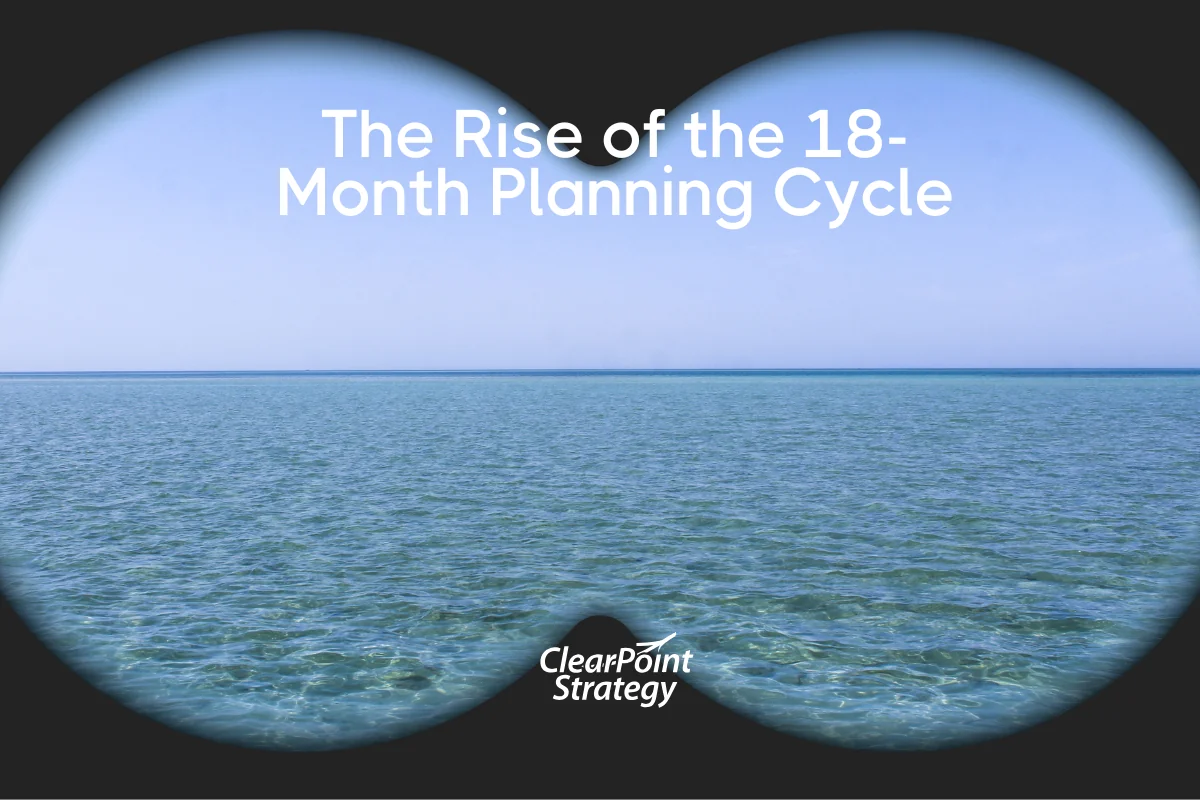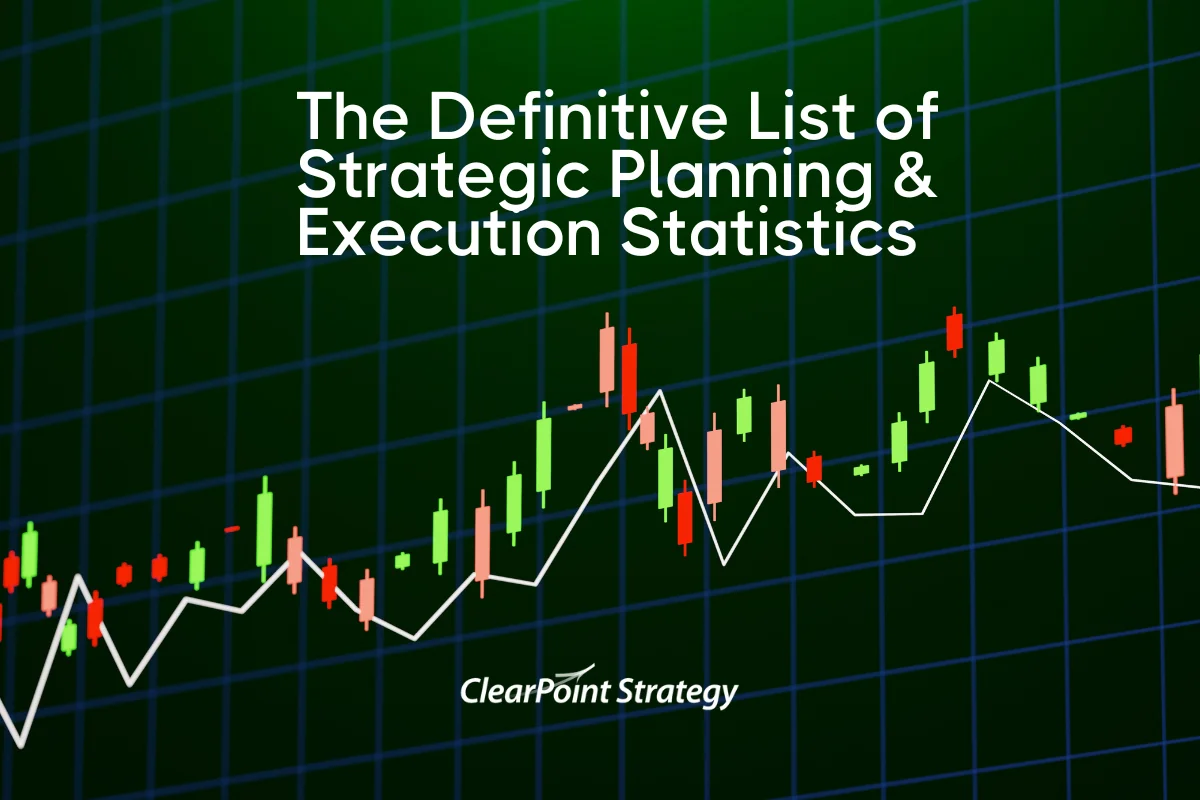How many goals should your organization be striving for at once? (Hint: fewer than you think!)
In strategy management, there’s always a tension between ambition and focus. Organizations want to achieve a lot, but too often that desire leads to bloated plans filled with vague or competing priorities. So somewhere between the planning session and execution, most of those goals quietly die.
The problem isn’t ambition. It’s focus.
Our research has revealed a clear truth: Success doesn’t come from having more goals; it comes from owning fewer goals better, and executing them with focus.
Here’s a look at what the data says about the sweet spot — the ideal number of objectives every organization should aim for — and why focusing on that number can dramatically improve execution.
Want even more strategic planning data to help you succeed in 2026? Download the full report here.
What is the ideal number of objectives?
After reviewing hundreds of thousands of strategic plans across sectors, we found something surprisingly consistent:
The ideal number of strategic objectives sits between five and nine.
It’s not a random range. It’s the sweet spot between complexity and clarity — enough to represent an organization’s breadth, but few enough to maintain focus and accountability.
Our research revealed that energy and utilities companies and local governments are the two top performing industries when it comes to achieving their objectives.
- Local governments have five median goals and a completion rate of 17.5%.
- Energy and utilities companies have nine median goals and a completion rate of 25.8% — the highest of any industry.
There are numerous other factors that play into their success (including project selection, measurement, timing, ownership, and more, all of which you can read about in our full data report), but these organizations prove that constraint is not limitation, it’s competitive advantage.
Why Too Many Objectives Are A Recipe For Disaster

Every extra objective adds coordination cost. Teams get stretched, reporting gets messy, and leadership loses sight of priorities. You start experiencing things like:
- A loss of accountability—Out of the more than 110,000 goals we studied, 74% had no assigned owner — in other words, literally no one is responsible for seeing that it gets done.
- A loss of engagement—Among the minimal number of owners, 77.49% never made progress updates. That indicates low engagement, a condition that doesn’t typically drive achievement.
- Overextended teams—Employees are easily overwhelmed by too many measures, causing them to get distracted from their main focus.
- Information overload—Too many objectives leads to too many measures. Decision-making is difficult when you’re drowning in data, and you end up with the sense that you’re reporting but not improving.
These are symptoms of a plan that’s trying to do everything and ends up doing nothing particularly well. The five-to-nine range isn’t arbitrary; it’s protection against diffusion.
Why is five to nine the ideal range?

The five-to-nine range gives organizations a distinct advantage:
- It provides clarity without dilution. Fewer goals provide focus. Teams understand what truly matters and can align resources accordingly. Too many goals create confusion and dilute effort.
- It promotes accountability. Each goal can be assigned to a clear owner, with one to two goals per executive and a small team of three to five collaborators. This ensures accountability and prevents goals from slipping through the cracks.
- It allows for strategic follow-through. Industries that maintain five to nine goals achieve completion rates 2–3x higher than those with 10+ goals. Fewer goals allow leaders to intervene early, track progress, and course-correct before failure occurs.
- It allows you to be flexible. The five-to-nine range allows organizations to sequence priorities. For example, a “five now, five next” model lets teams pursue current goals with full focus while keeping future initiatives queued for subsequent cycles.
- It increases your execution capacity. With fewer top-level goals, teams can expand the number of projects per goal, translating strategic intent into tangible action.
Five to nine is the ideal range but getting to that level of focus takes discipline. In fact, most organizations begin far from it. First attempts at strategy mapping usually include close to 15 objectives.
That’s not necessarily bad.
Early-stage strategies often reflect the organization’s entire operating environment. They include “keep the lights on” priorities, improvement projects, and long-term ambitions all jumbled together. At this stage, more objectives simply mirror the organization’s complexity.
Over time, though, as strategy management matures, something important happens: Leadership teams start consolidating. They merge similar objectives, clarify purpose, and retire the noise. The strategy becomes crisper, simpler, and more focused — and the number of objectives naturally falls into that five to nine range.
Less Breadth, More Depth: What Replaces Those Missing Objectives
When organizations streamline from 15 objectives to, say, seven, they don’t lose strategic richness, they just express it differently.
Each objective becomes more robust. Instead of a single vague line like “Enhance customer satisfaction,” you’ll see a well-written objective statement — one or two sentences explaining the intent, scope, and impact. These statements bring substance and context, so the objective feels actionable rather than aspirational.
For example:
“Enhance customer satisfaction by streamlining response times, empowering front-line staff to resolve issues on first contact, and leveraging feedback loops to inform product development.”
That’s not fluff. It’s direction. It’s what makes fewer objectives work just as hard as many.
The Multiplier Effect of Measures And Initiatives
Here’s where things get interesting. As the number of objectives decreases, the number of measures increases — often doubling.
A mature strategy with seven objectives might have 10–20 measures total. Why? Because each objective deserves multiple lenses of success.
For instance, an objective around “Operational Excellence” might have:
- A process efficiency measure (e.g., average processing time)
- A quality measure (e.g., error rate)
- A satisfaction measure (e.g., customer or employee satisfaction score)
This layering ensures that you’re not chasing a single metric at the expense of the bigger picture.
Then, beneath those measures come the initiatives — typically around eight major projects per plan. These are the tangible efforts driving change: system upgrades, process improvements, or policy shifts that ladder up to your objectives.
Put it together, and your structure looks something like this:
Even with fewer objectives, this structure forms a robust and balanced strategy that is wide enough to cover your organization’s needs but tight enough to execute.
A Few Practical Tips For Getting There
- Start broad, then edit ruthlessly. If your first map has 15 objectives, that’s fine. But after your first review cycle, look for overlap and redundancy.
- Use objective statements to drive clarity. Every objective should pass the “so what?” test. Two sentences should explain why it exists and how you’ll know if it’s been achieved.
- Group by theme. Use categories like “Customer,” “Operations,” “People,” and “Finance” to see balance and identify excess.
- Link your data. Pair every objective with measures and initiatives early. It forces you to define success concretely.
- Review quarterly. Ask: “Does this objective still reflect our strategic intent?” If not, merge or retire it.
The Takeaway: Focus, Accountability, and Discipline Win
Bottom line: Five to nine goals provides a balance between ambition and focus. It’s enough to capture strategic intent but constrained enough to drive ownership, follow-through, and measurable results.
But remember: Starting with 15 objectives isn’t failure; it’s part of the process.
If your plan has 5–9 clear, meaningful objectives — each supported by 10–20 well-chosen measures and 8 active initiatives — you’re not under-planning. You’re focused. You’ve built a strategy that’s clear, measurable, and sustainable. And that’s the key to success.

.svg)





